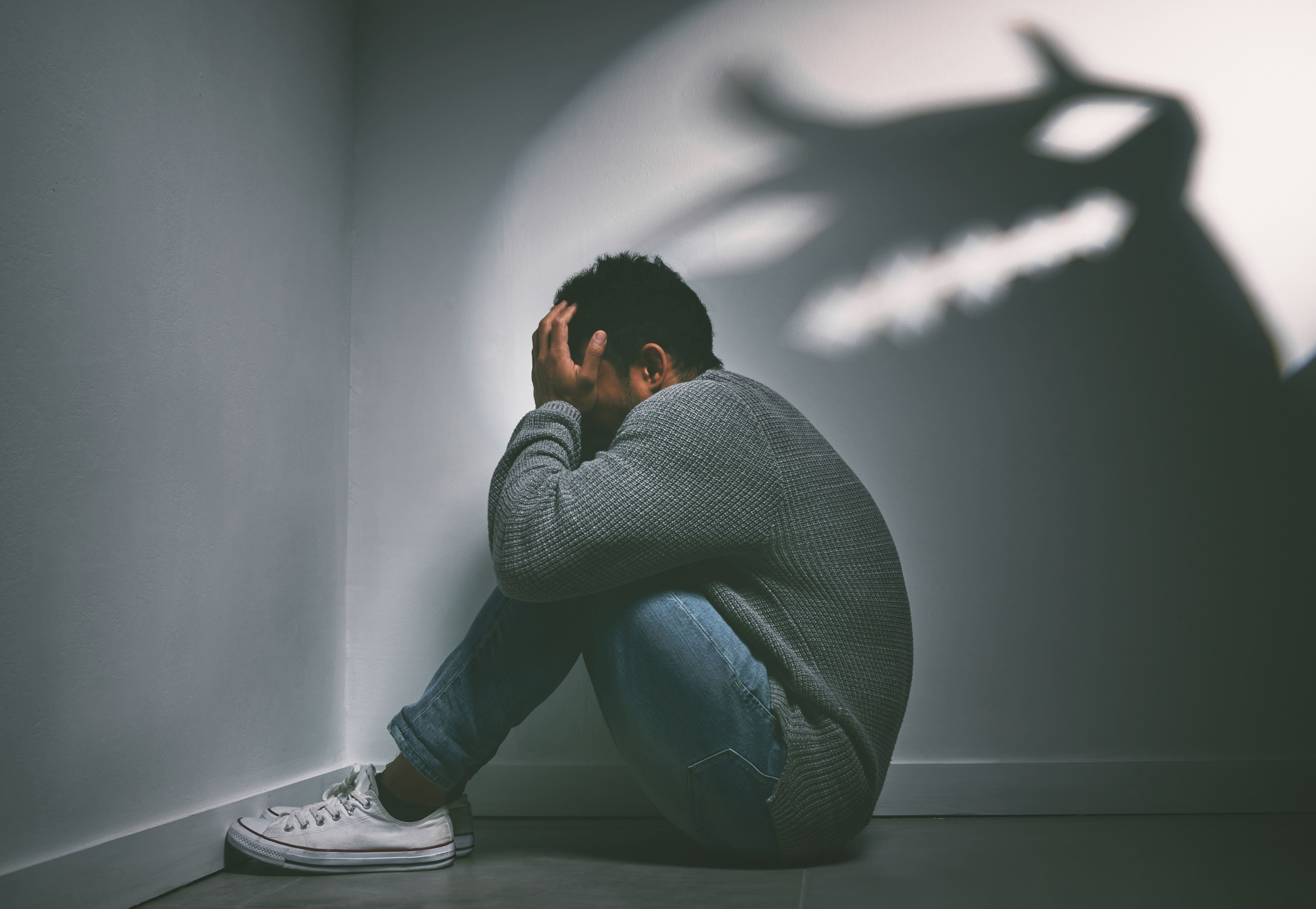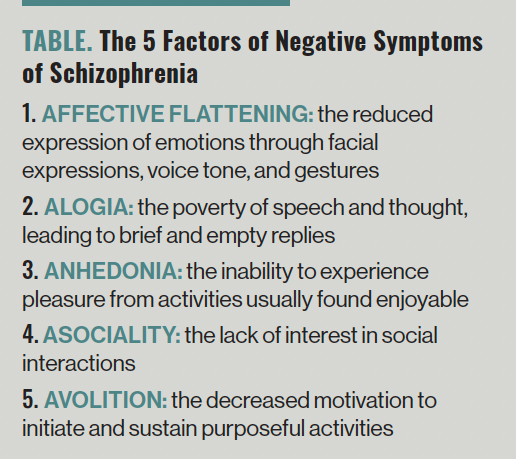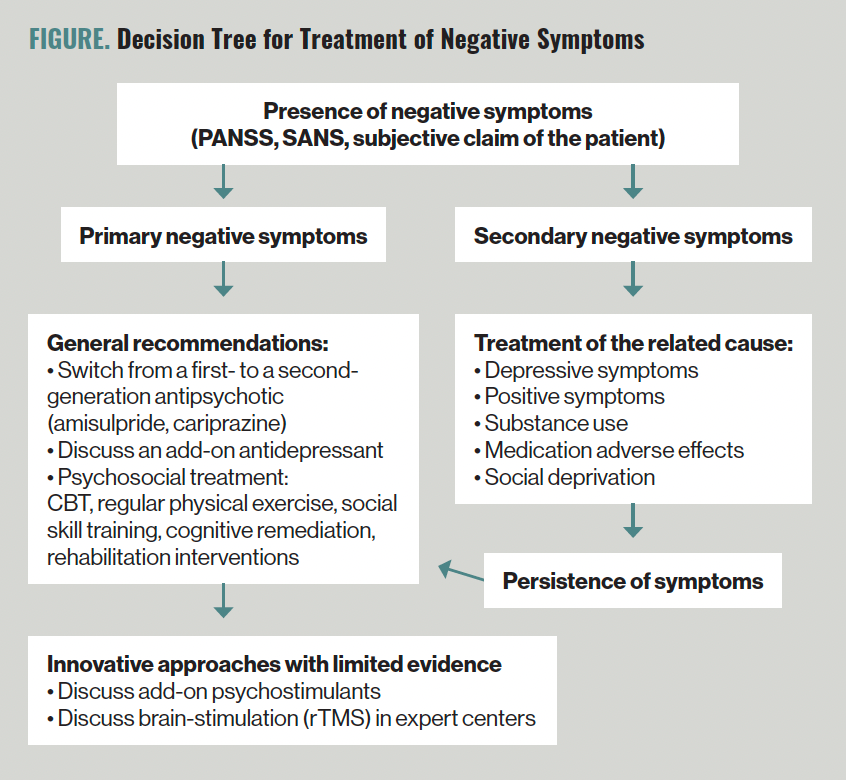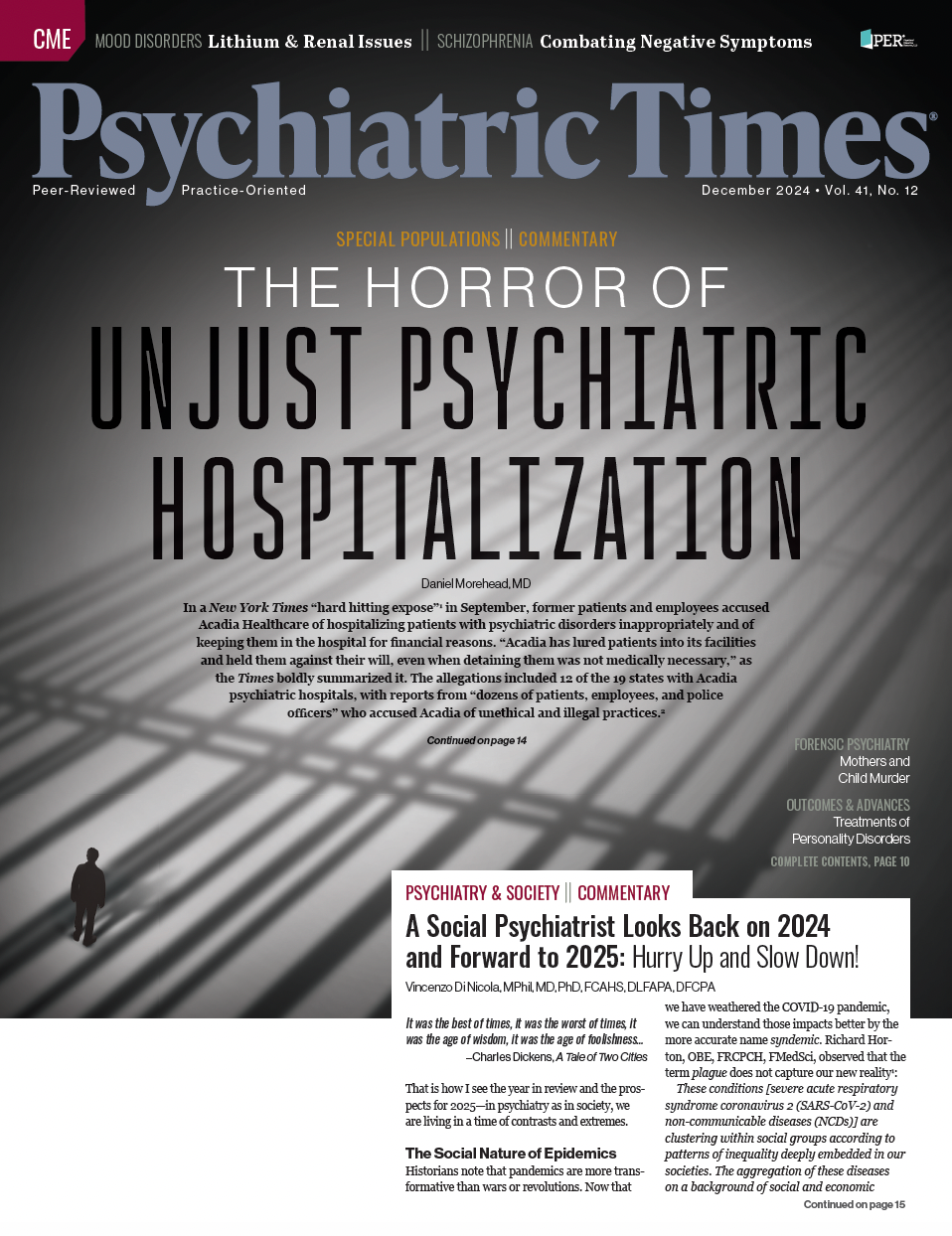Publication
Article
Psychiatric Times
Combating Negative Symptoms in Schizophrenia: Updated Treatment Approaches
Author(s):
Key Takeaways
- Negative symptoms in schizophrenia, including diminished expression and apathy, are challenging to treat and often resist conventional antipsychotics targeting positive symptoms.
- Distinguishing primary from secondary negative symptoms is crucial, as secondary symptoms may arise from factors like medication side effects or comorbid conditions.
Negative symptoms pose significant challenges for individuals with schizophrenia and their caregivers.
Siphosethu Fanti/peopleimages.com/AdobeStock

Schizophrenia is a frequently chronic and disabling disorder, marked by heterogeneous positive and negative symptom constellations.1 While antipsychotic medications usually manage positive symptoms effectively, there are limited treatment options for negative symptoms. Despite progress in understanding schizophrenia’s etiology, biology, and psychopharmacology, negative symptoms remain an unmet medical need.
Negative symptoms pose significant challenges for individuals with schizophrenia and their caregivers. These symptoms can be described in 5 factors (Table).
Table. The 5 Factors of Negative Symptoms of Schizophrenia

These symptoms severely impair daily functioning and can be resistant to conventional antipsychotic treatments, which primarily target positive symptoms by modulating dopamine pathways in the brain. From a phenomenological point of view, negative symptoms can be described within 2 dimensions: (1) the dimension of diminished expression, comprising alogia and blunted affect; and (2) the dimension of apathy, comprising avolition, asociality, and anhedonia. These 2 distinct dimensions are thought to have different underlying neurobiological mechanisms. Distinguishing primary negative symptoms from secondary negative symptoms is therefore an essential part of the treatment approach.2
Primary negative symptoms are thought to be intrinsic to the underlying pathophysiology of schizophrenia, while secondary negative symptoms are thought to be related to other factors.3 These factors include positive symptoms, treatment adverse effects (sedation, extrapyramidal symptoms, akathisia), anxious and depressive symptoms, environmental deprivation, substance use, other comorbid psychiatric disorders, and medical comorbidities.
For instance, investigators describe a complex relationship between negative symptoms and depression in schizophrenia. Indeed, affective symptoms are commonly observed in nonaffective psychosis, affecting 50% to 80% of patients at some point during their illness.4 Primary evidence indicates that low mood, suicidal thoughts, and pessimism are more specifically linked to depression, while alogia and blunted affect are more closely associated with negative symptoms. Nevertheless, anhedonia, anergia, and avolition may be present in both conditions.5 Therefore, a thorough evaluation of clinical symptoms in individuals with schizophrenia is essential to accurately identify their nature and tailor the treatment accordingly.6
The causes of depressive symptoms in schizophrenia are diverse, including dysphoria induced by antipsychotic medications, psychological stressors, stigma, and traumatic life events.7 Addressing these causes requires a combination of nonpharmacological and pharmacological approaches. In this specific case, a switch to an antipsychotic with antidepressant properties should be considered. Add-on antidepressant is another potential option, as are cognitive behavior therapy sessions.8
Pharmacologic Treatments
Another important point is the need to avoid first-generation antipsychotics, as these dopamine antagonists present a significant risk of inducing secondary negative symptoms due to their dose-dependent adverse effects: sedation, extrapyramidal symptoms, lower motivation, and mood. Regarding second-generation or third-generation antipsychotics, there is limited evidence based on very few randomized controlled trials (RCTs). Although amisulpride selectively blocks dopamine D2 and D3 receptors, at low doses (50 to 300 mg/day) it preferentially blocks presynaptic dopamine receptors, which may enhance dopaminergic transmission in pathways associated with negative symptoms. This contrasts with higher doses, at which it blocks postsynaptic receptors to alleviate positive symptoms.
Cariprazine is also promising for the treatment of predominant and persistent negative symptoms. This second-generation antipsychotic has demonstrated efficacy in reducing negative symptoms. It acts as a partial agonist at dopamine D2 and D3 receptors with a higher affinity for D3 receptors, which are believed to play a significant role in cognitive and emotional processes. Clinical trials have shown that cariprazine not only improves positive symptoms but also has a significant impact on negative symptoms. However, current evidence is limited to a few RCTs published by the same manufacturer.9
Clozapine is another second-generation antipsychotic. Although clozapine presents a weak affinity for D2 receptors and antagonizes D1 and D4 receptors, it is thought to regulate glutamatergic neurotransmission, which can be beneficial for negative symptoms in schizophrenia, particularly secondary negative symptoms related to treatment-resistant positive symptoms or comorbid depression. Its efficacy for primary negative symptoms is less clear, with some studies showing modest benefits.
Novel mechanism-of-action (MOA) agents such as pimavanserin are emerging for treatment of both positive and negative symptoms of schizophrenia with very interesting results.10 Pimavanserin is a selective serotonin 5-HT2A agonist/antagonist and a 5-HT2C receptor antagonist. In a phase 2 trial, stable patients with predominant negative symptoms of schizophrenia showed a reduction in negative symptoms after treatment with pimavanserin.10 However, only a small effect size was found. Therefore, further investigation with optimized dosing is warranted to determine the clinical significance of this effect.
Overall, for pharmacological approaches, there is a lack of high-level evidence supporting specific interventions. Further research is necessary before recommending amisulpride or cariprazine as a treatment for negative symptoms in clinical practice.
Nonpharmacological Treatments
Nonpharmacological treatment methods have been found to be effective in the treatment of patients with undifferentiated negative symptoms of schizophrenia.11 For instance, patients with negative symptoms should have access to rehabilitation interventions such as supported employment and supported housing. We present in the Figure a decision tree for current recommendations of the treatment of negative symptoms in individuals with schizophrenia. Recent advancements in medical research have introduced potential novel treatments aimed at addressing these debilitating negative symptoms, offering new hope for improving the quality of life for those affected by this condition.
Figure. Decision Tree for Treatment of Negative Symptoms

The add-on of psychostimulants to concurrent antipsychotics has been studied, with various RCTs with modafinil and armodafinil. However, only limited improvement for patients with predominant negative symptoms has been found to date, which precludes current recommendation in clinical practice, pending further research.12
Transcranial magnetic stimulation (TMS) is a noninvasive procedure that uses magnetic fields to stimulate nerve cells in the brain. Research has shown that TMS can be effective in reducing negative symptoms by targeting specific brain regions involved in mood and cognition. Although many RCTs have been published, there is significant heterogeneity among included patients and stimulation parameters used.13 Nevertheless, in expert centers, treatment with left prefrontal repetitive TMS can be considered for patients with negative symptoms that do not improve with other interventions.11
Original and very recent interventions are starting to be proposed to target negative symptoms in individuals with schizophrenia, such as the use of specific serotonergic psychedelics. Arnovitz et al propose 3,4-methylenedioxymethamphetamine (MDMA) as a novel therapeutic given its ability to enhance social interactions, generate empathy, and induce a state of metaplasticity in the brain.14 MDMA has been shown to be an effective treatment for posttraumatic stress disorder. An open-label, ascending-dose, within-subject trial of MDMA (dose, 40-120 mg) is being conducted in the US for individuals with schizophrenia presenting negative symptoms (NCT05770375). Psilocybin, a serotonergic psychedelic, also exhibits entactogenic properties and may be of interest in addressing the negative symptoms of schizophrenia.15 However, the psychedelic experience or “trip” associated with these substances is controversial when considering their use as potential add-on therapies as they may trigger adverse effects in individuals with schizophrenia.
Moreover, most second-generation antipsychotics (eg, risperidone, olanzapine) act as “trip stoppers,” preventing patients from experiencing the psychedelic effects that might be beneficial. Furthermore, the combination of first-generation antipsychotics with psychedelics could amplify the effects of the psychedelics, increasing the risk of worsening adverse symptoms in patients.16 It remains an open question whether the psychedelic trip is necessary to achieve the antidepressant effects of these substances. Husain et al proposed an innovative double dummy trial in patients with treatment-resistant depression to try to answer to this question.17
However, certain antipsychotics, such as amisulpride at moderate doses (eg, 400 mg), could theoretically be used to prevent a potential increase in positive symptoms following psychedelic use while still allowing the psychedelic experience to occur. Nevertheless, switching a stable patient’s antipsychotic regimen to accommodate the potential benefits of an add-on psychedelic treatment is also a matter of debate.
Finally, the assessment of negative symptoms is also evolving with promises from digital phenotyping, offering a more precise and continuous method of monitoring than traditional assessments. By leveraging data from smartphones, wearable devices, and other digital tools, digital phenotyping can capture subtle behavioral and physiological changes that may indicate the presence or severity of negative symptoms, such as social withdrawal, reduced motivation, and diminished emotional expression. This real-time, objective data can complement clinical evaluations, providing a more comprehensive understanding of a patient’s condition and enabling personalized treatment approaches. Additionally, digital phenotyping can help in early detection of symptom exacerbation, potentially leading to timely interventions that improve outcomes for individuals with schizophrenia.18
Concluding Thoughts
In sum, negative symptoms in schizophrenia represent a significant challenge, both in terms of patient suffering and the limitations of current treatment approaches. While advancements in pharmacological and nonpharmacological treatments show promise, particularly with novel interventions like digital phenotyping,novel MOA agents, and psychedelics, much remains to be understood and validated through rigorous research.
Dr Sabé is faculty in the Division of Adult Psychiatry in the Department of Psychiatry at the University Hospitals of Geneva in Geneva, Switzerland, as well as faculty of medicine at the University of Geneva in Geneva, Switzerland.
References
1. Solmi M, Seitidis G, Mavridis D, et al. Incidence, prevalence, and global burden of schizophrenia - data, with critical appraisal, from the Global Burden of Disease (GBD) 2019. Mol Psychiatry. 2023;28(12):5319-5327.
2. Kirschner M, Aleman A, Kaiser S. Secondary negative symptoms - a review of mechanisms, assessment and treatment. Schizophr Res. 2017;186:29-38.
3. Correll CU, Schooler NR. Negative symptoms in schizophrenia: a review and clinical guide for recognition, assessment, and treatment. Neuropsychiatr Dis Treat. 2020;16:519-534.
4. Upthegrove R, Birchwood M, Ross K, et al. The evolution of depression and suicidality in first episode psychosis. Acta Psychiatr Scand. 2010;122(3):211-218.
5. Krynicki CR, Upthegrove R, Deakin JFW, Barnes TRE. The relationship between negative symptoms and depression in schizophrenia: a systematic review. Acta Psychiatr Scand. 2018;137(5):380-390.
6. Galderisi S, Mucci A, Dollfus S, et al. EPA guidance on assessment of negative symptoms in schizophrenia. Eur Psychiatry. 2021;64(1):e23.
7. Wu HE, Okusaga OO. Antipsychotic medication-induced dysphoria: its meaning, association with typical vs. atypical medications and impact on adherence. Psychiatr Q. 2015;86(2):199-205.
8. Helfer B, Samara MT, Huhn M, et al. Efficacy and safety of antidepressants added to antipsychotics for schizophrenia: a systematic review and meta-analysis. Am J Psychiatry. 2016;173(9):876-886.
9. Krause M, Zhu Y, Huhn M, et al. Antipsychotic drugs for patients with schizophrenia and predominant or prominent negative symptoms: a systematic review and meta-analysis. Eur Arch Psychiatry Clin Neurosci. 2018;268(7):625-639.
10. Bugarski-Kirola D, Arango C, Fava M, et al. Pimavanserin for negative symptoms of schizophrenia: results from the ADVANCE phase 2 randomised, placebo-controlled trial in North America and Europe. Lancet Psychiatry. 2022;9(1):46-58.
11. Galderisi S, Kaiser S, Bitter I, et al. EPA guidance on treatment of negative symptoms in schizophrenia. Eur Psychiatry. 2021;64(1):e21.
12. Sabé M, Kirschner M, Kaiser S. Prodopaminergic drugs for treating the negative symptoms of schizophrenia:systematic review and meta-analysis of randomized controlled trials. J Clin Psychopharmacol. 2019;39(6):658-664.
13. Sabé M, Hyde J, Cramer C, et al. Transcranial magnetic stimulation and transcranial direct current stimulation across mental disorders: a systematic review and dose-response meta-analysis. JAMA Netw Open. 2024;7(5):e2412616.
14. Arnovitz MD, Spitzberg AJ, Davani AJ, et al. MDMA for the treatment of negative symptoms in schizophrenia. J Clin Med. 2022;11(12):3255.
15. Coppola M, Bevione F, Mondola R. Psilocybin for treating psychiatric disorders: a psychonaut legend or a promising therapeutic perspective? J Xenobiot. 2022;12(1):41-52.
16. Vollenweider F, Vollenweider-Scherpenhuyzen M, Bäbler A, et al. Psilocybin induces schizophrenia-like psychosis in humans via a serotonin-2 agonist action. Neuroreport. 1999;9(17):3897-3902.
17. Husain MI, Blumberger DM, Castle DJ, et al. Psilocybin for treatment-resistant depression without psychedelic effects: study protocol for a 4-week, double-blind, proof-of-concept randomised controlled trial. BJPsych Open. 2023;9(4):e134.
18. Cohen AS, Schwartz E, Le TP, et al. Digital phenotyping of negative symptoms: the relationship to clinician ratings. Schizophr Bull. 2021;47(1):44-53.






